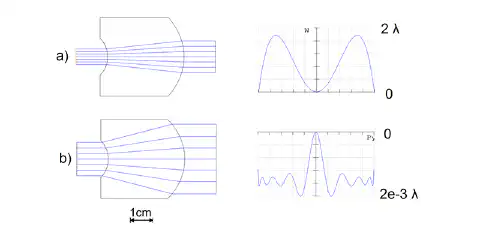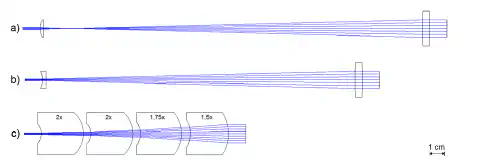
Beam Expansion
Methods to expand or reduce a light or laser beam
Content
Beam expansion is a method to expand or reduce a light or laser beam, that is realized by an optical system (beam expansion system).
Beam expansion systems
Beam expansion systems (also referred to as Beam Expander) are used for optimum adaption of beam cross sections between light sources (i.e. laser) and the following optical element. Accurate illumination of optically effective surface is especially essential for beam formation and focusing with high numerical apertures. The commonly basic principles of afocal beam expansion systems can be traced back to the Keplerian telescope and the Galilean telescope.
Classic beam expansion systems
The design of the Kepler telescope represents the simplest principle of a beam expansion system. Here, two converging lenses with different focal lengths are combined. The expansion or reduction of the beam cross section results from the quotient of the focal length
(1)
The overall length of the optical system is essentially determined by distance of the two lenses, which can be estimated over the sum of the focal length,
(2)
In the Galilean telescope, the converging lens is replaced by a diverging lens, which decreases the construction lengths while maintaining the magnification level. Figure 1 shows both: Kepler telescope (a) and Galilean telescope (b) with 10x magnification (V=10).

Figure 1: Comparison of classical systems for laser beam expansion with 10x magnification (V=10); (a) Kepler telescope, (b) Galilean telescope
Asperization and flexible magnification levels
Spheric single lenses are used in classic beam expansion systems. Thus, spheric aberrations become visible. This can be remedied by asperization of one of the lens surfaces, particular where a high quality of wave front is required. The shape of the lens surface can be described by
(3)
These beam expansion systems are typically optimized for one wavelength in terms of the shape of optical surface and lens distance. Spheric aberrations can be reduced to a minimum. By adding an additional optical group, the beam expansion system receives additional flexibility with regard to the adjustable magnification levels. This can be done most easily with a symmetrical zoom system, which consists of three single optical lenses (converging lens-diverging lens-converging lens). Therby two lenses must be able to change their position so that an afocal beam path is ensured for each magnification level. Depending on requirements, such a system can become very complex, whereby the demands increas in terms of the mechanical mount.
Monolithic beam expansion systems
A slightly different approach is taken by monolithic beam expansion systems that are similar in operating principle to a Galilean telescope, but consists only of one optical element – a meniscus lens. The two optically active surfaces have a common center of curvature. The principle of this so-called zero lenses has been known for a very long time, but they show strong spherical aberration in their original design with two spherical surfaces and thus are only suitable for very small beam diameters and very low magnifications. In Figure 2 (a) the beam path in such a spherical lens is shown schematically. If these optical elements are aspherized to one of the two surfaces, the spherical aberration can be corrected and an afocal system for large beam diameters can be implemented.

Figure 2: Schematic comparison between spherical and aspheric beam expansion
The improvement in the optical properties can be clearly seen in comparison to Figure 1. The magnification in both cases corresponds to V = 2, whereby the beam diameter is different by the factor 2. The maximum attainable magnification of such a single element is V = 2. This is estimated by the paraxial magnification
(4)
whereby n is the refractive index of the glass, r is the radius of the concave side, and d is the center thickness. It turns out that the single element magnifications of the monolithic Galilean telescopes are comparatively low due to the overall length limitation. Since it is an afocal beam expansion systems, they can gradually increase the input beam while they are “connected in series” in succession in the beam path (Figure 3c).

Comparison of the beam expansion systems Kepler and Galilean telescope with the a|BeamExpander in a cascade Figure 3: Comparison of the systems for a 10x beam expansion ((a) Kepler telescope, (b) Galilean telescope) extended by asphericons a|BeamExpander. This one achieves up to 50 % shorter overall lengths - even when used in a cascade.
Various magnification levels allow both, high magnifications with minimum space requirements (use V = 2) as well as finer increments (use V = 1.5 and V = 1.75). Due to the afocal design of the single elements, the meniscus lenses can arbitrarily oriented inside the beam path. The use of monolithic beam expansion systems in cascade involves much more optical surfaces than the conventional optical systems (see Figure 3). Moreover, each second surface is aspheric! For such a cascade system for flexible beam expansion very high surface qualities of the single elements are required. Prerequisite for a variety of combinations during the subsequent use is that every single element over the entire clear aperture must be significantly better than the requirement “diffraction limited”, that is wavefront error RMS< λ/14. If, at the same time, center thickness and decentering of the surfaces are very accurately manufactured, one can speak of a completely adjustment-free beam expansion system, since all degrees of freedom required for adjustment are fixed at an optimum by the manufacturing as monolithic element. Also, the introduction of further monolithic elements for changing the magnification level will be completely adjustment-free and therefore quick and easy
Fields of application
Beam Expander are primary used for research in the optics laboratory, where they are used for example to amplify the laser or to improve the usability of the optical assembly. Also in the research and development departments of aerospace, biotechnology, imaging, materials research and materials processing, particularly of laser material processing, beam expander systems are used.
